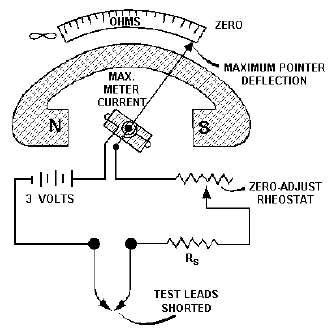3-18
Figure 3-12.—Simple ohmmeter circuit.
A source of dc potential; and
One or more resistors (one of which is variable).
Q-21. What added features enable a dc milliammeter to function as an ohmmeter?
The deflection of the pointer of an ohmmeter is controlled by the amount of battery current passing
through the moving coil. Before you can measure the resistance of an unknown resistor or electrical
circuit, you must calibrate the ohmmeter to be used. If the value of resistance to be measured can be
estimated within reasonable limits, select a range on the ohmmeter that will give approximately half-scale
deflection when the resistance is inserted between the probes. If you cannot estimate the resistance to be
measured, then set the range switch on the highest scale. Whatever range you select, the meter must be
calibrated to read zero before the unknown resistance is measured.
To calibrate the meter, you first short the test leads together, as shown in figure 3-12. With the test
leads shorted, a complete series circuit exists. The complete series circuit consists of the 3-volt source, the
resistance of the meter coil (R
meter), the resistance of the zero-adjust rheostat, and the series multiplying
resistor (Rseries). The shorted test leads cause current to flow and the meter pointer to deflect.
Notice that the zero point on the ohmmeter scale (as opposed to the zero points for voltage and
current) is located at the extreme right side of the scale. With the test leads shorted, the zero-adjust
potentiometer is set so that the pointer rests on the zero mark. Therefore, a full-scale deflection indicates
zero resistance between the leads.
Q-22. A full-scale deflection on an ohmmeter scale indicates what resistance between the leads?
If you change the range on the meter, you must "zero" (calibrate) the meter again to obtain an
accurate reading. When you separate the test leads, the pointer of the meter will return to the left side of
the scale. This action, as explained earlier, is caused by the restoring force of the spring tension acting on
the movable coil assembly. The reading at the left side of the scale indicates an infinite resistance.

